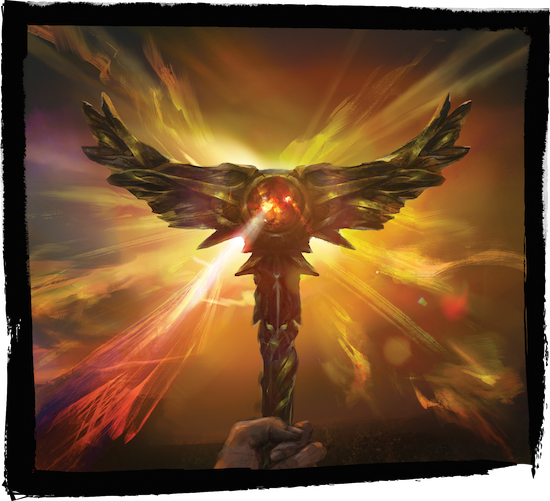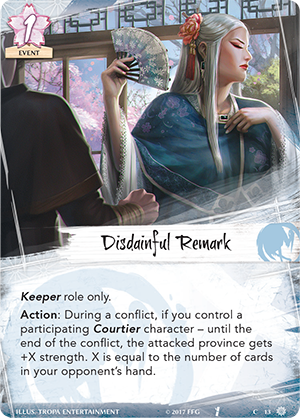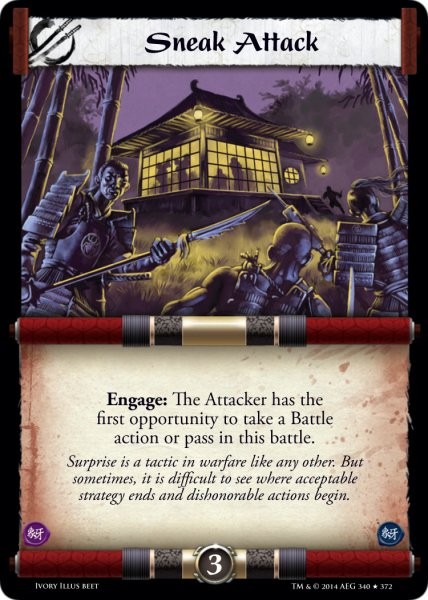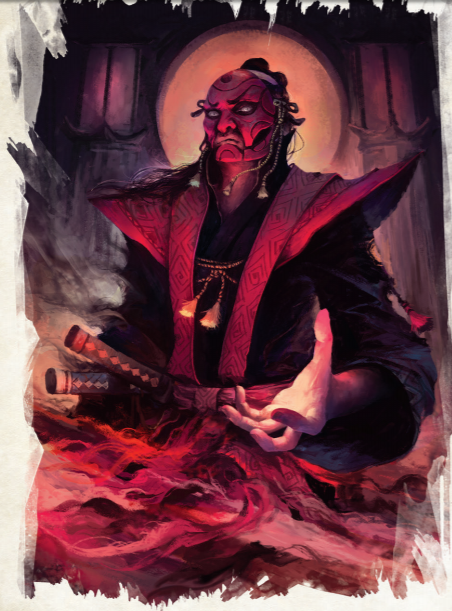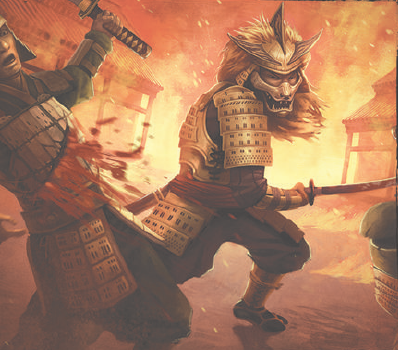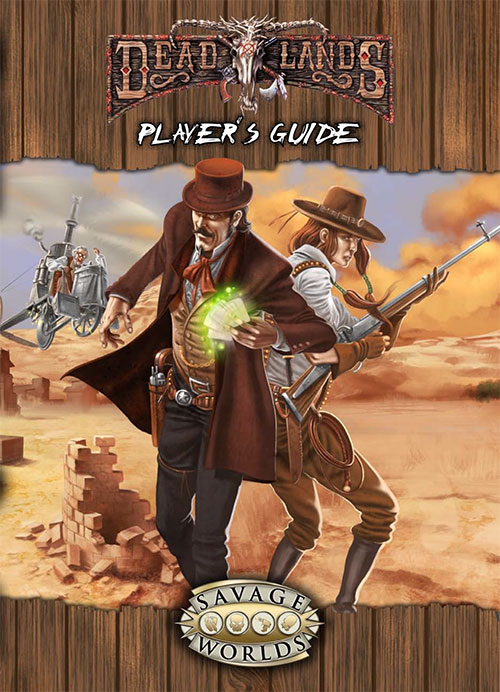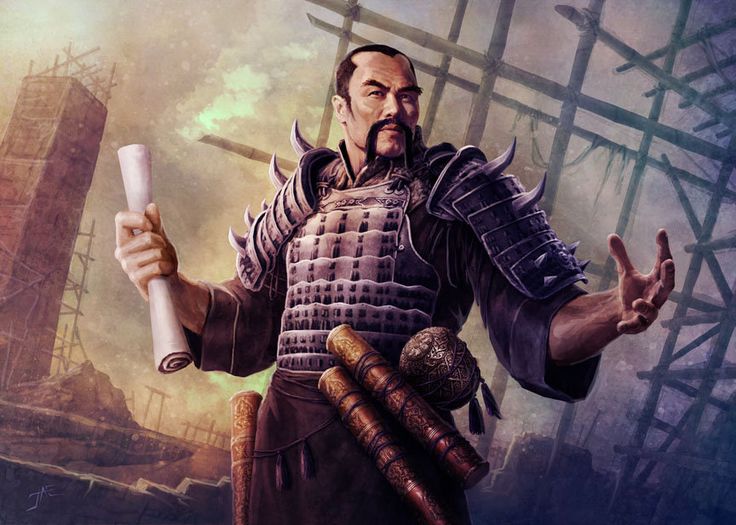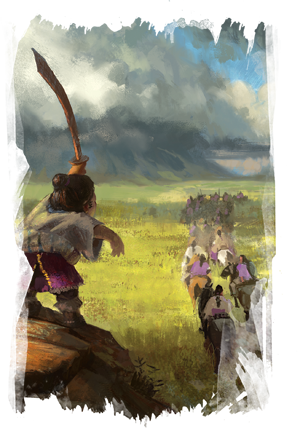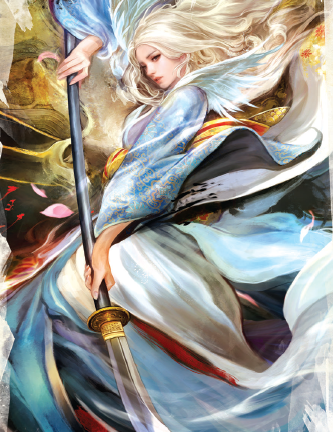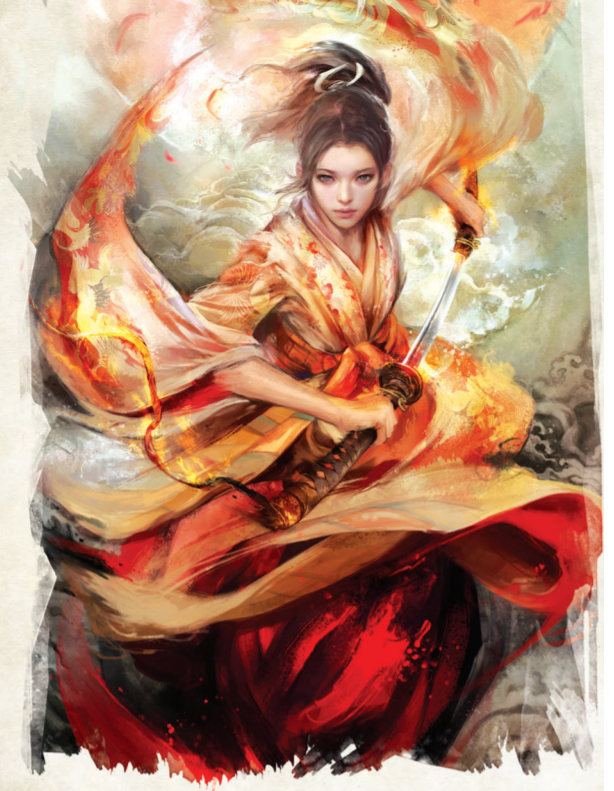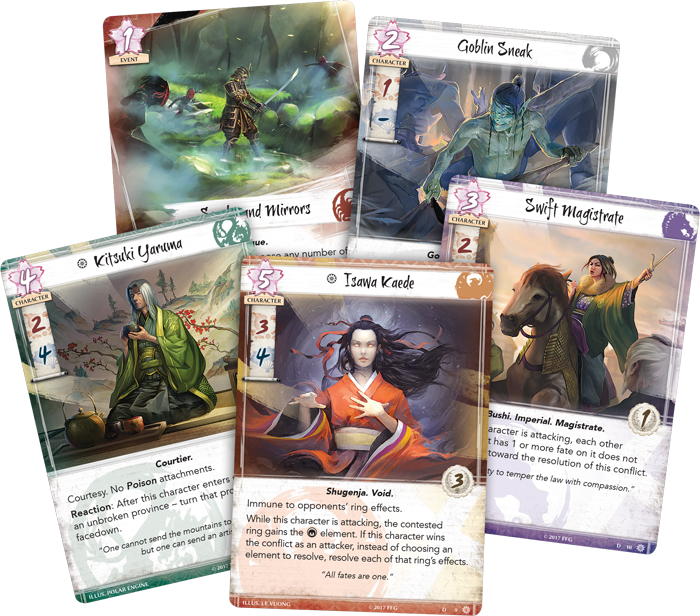Originating as a series chronicling David Gordon’s return to the Legend of the Five Rings CCG after a several year absence, Dave of the Five Rings continued on as he examined the current and future of the iconic world of Rokugan upon the game’s sale to FFG in 2015.
Chapter 24: Cultural Appropriation
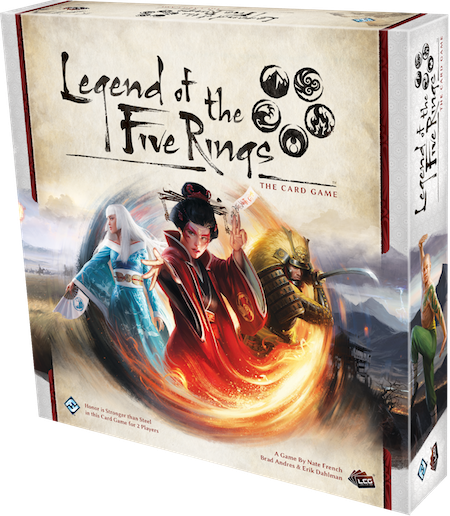
It has been a long journey for the rebirth of Legend of the Five Rings. By the time this article is published, we will have seen its return after two years to the shelves of gaming stores. Re-released by Fantasy Flight Games, Legend of the Five Rings is a Living Card Game (LCG) with an undeniable history in competitive gaming culture, and is one of the few games besides Magic: the Gathering to have flourished in the 1990s and survive into the 2010s. It tells the tale of magical samurai in the Emerald Empire of Rokugan, feuding between each other to earn the favor of the Emperor and glory for their Great Clan.
However, despite a lengthy lifespan and a dedicated and loyal fanbase, its record has been far from perfect. L5R has seen its popularity rise and fall over the years due to a variety of missteps, mistakes, and an inherent resistance to change – let alone acknowledge – some of its most troubling and problematic aspects. Aspects that have been part of its identity since its very inception. With L5R returning to the spotlight and the potential to reach a whole new audience of players, it’s high time we address some of those issues.
Let me begin with that this is not going to be an easy article to read, especially if you are a fan of Legend of the Five Rings. As an avid fan of L5R, it certainly has not been an easy article to write. By the time you see this article, dear reader, it will have been re-written more than any of my previous articles, as I am insistent on finding one which says what I feels needs to be said and approaches the issues at hand sufficiently and respectfully. Yet it is through examination and thoughtful struggle that we make ourselves better.
With that being said, the topic before us today begins with a very straightforward question: Is the Legend of the Five Rings cultural appropriation?
The easy answer, simply, is “Yes.” The far more complicated and complex answer is “Yes, but that is not itself a bad thing.” Therein that distinction lies where the majority of this article lives. This is not going to be the end-all, be-all of this subject we are about to approach, but it is a start.
Points of Reference
Before we go any farther, however, I would like to bring certain things into a common vocabulary. We cannot discuss these matters if our words do not match the intended meaning. As such, please take a moment and watch some of the following essays: Extra History’s segment on the Sengoku Jidai period of Japanese history, an introduction to Edward Said’s Orientalism, and Lindsay Ellis’ video essay about Pocahontas. Also, I would recommend you read Wikipedia articles on the Japanese occupation of Manchuria and Korea, the Banzai charge in WWII, and Inazo Nitobe’s text Bushido: the Soul of Japan.
Lastly, above all else, keep an open mind. We are going into material which will likely make a fan of Legend of the Five Rings feel attacked and possibly ashamed. It is important to remember that it is only through such examination can we make this community better, and knowing where we have fallen short does not negate where we have succeed. (L5R’s long history of charitable efforts and the One Heart tournaments after 9/11, I am looking at you!)
Then And Now
So. With all that out there, let us unpack exactly what Legend of the Five Rings is. L5R is a complex card game with strong in-group, out-group mechanics which have encouraged the development of fan communities around its factions from the very start. It was created in the 1990’s by a group of white American men, and was marketed primarily to American men and women during a time when there was a rising obsession with Japanese culture in geek communities. L5R also hit just as anime started going mainstream in the United States, and it tapped into both those elements, as well as the general cultural fascination America has had with Japan since the early 20th century.
The game’s initial creation was not intended to be sustainable, as the original writers had planned just to tell a two year story in the game before moving on. It was the fan community that emerged from the game which made them change their minds, for as much commercial as artistic reasons. L5R had quickly proved to be a market-sustainable game.
At its best, Legend of the Five Rings reaches past the challenges of its creation and can lead to a place of greater understanding and inclusiveness. While it may have started with an ignorant appropriation of certain elements of Japanese history, with the release of the RPG in 1997, Legend of the Five Rings gave space to a greater study of those elements.
Through both the RPG and the fiction released as part of the game’s evolution, the people behind L5R began to examine the consequences of being in a world framed by an extreme moral and ethical code which demand self-sacrifice and blind obedience. Characters were given room to breathe, think, grow and change, to be people beyond images on cardboard and cultural stereotypes.
The character of Bayushi Kachiko stands as a textbook example of a common American trope which fetishizes Asian women, but she was given room in subsequent depictions to undermine and deconstruct that trope. While the Great Clans of Rokugan are a mishmash hodgepodge of various pieces of Japanese history, with oddly non-Japanese elements incorporated into them, the communities which sprung up around them in the fandom of Legend of the Five Rings brought a whole new life (and meaning) to them – a trait which persisted long after the game went into decline. Being a Crab player meant being part of a community, no matter your gender identity, ethnicity, or sexual preference. You were a Crab Clan player, and that meant you were one of us.
At its best, Legend of the Five Rings moved past its origins as a very American enterprise cashing in on a rising tide in pop culture to become a community which celebrates elements of Japanese history and a shared identity focused around exciting gameplay. The success of the L5R re-release at Gen Con 2017 has shown this to still be accurate. There is still a vibrant community of L5R players willing to return to the game after two years away (more in many cases), and there are many newcomers whom are interested in playing this game.
The Trouble of Selective Inspiration
However, at a certain point, one cannot escape certain facts. The Legend of the Five Rings LCG is still an American-designed game steeped in a fantasy setting which appropriates heavily from Japanese history and myth, filtered very much through a Western / American lens. Further, it appropriates incongruous elements of Chinese, Korean, and southeast Asian heritage into its narrative and visual language without demonstrating a deep understanding of where those elements themselves originate or how they relate historically to Japan.
Even the long-standing tradition of the call and response battle cry “Utz! Banzai!”, which has started every Gen Con (and many other L5R tournaments), is not without a troubling historical context for certain ethnicities. For some, it is the battle cry of a people who historically victimized their ancestors. For others, it is the memory of how Japanese soldiers would commit to suicide charges against American soldiers in WWII rather than be defeated. But for most of the L5R community? It is simply an artifact of a fantasy setting devoid of any historical context before the Second Day of Thunder tournament in 1997.
To bring it into personal perspective, I considered how I would feel if every Deadlands tournament started with a battlecry of “Geronimo!” Similar to the Banzai, it is a cultural element shouted by troops before beginning battle. In my case, as a Native American, Geronimo is a real and relevant historical figure of resistance to genocide and governmental aggression. It was adopted by WWII paratroopers as a battle cry to show their bravery (after one watched an early Western about Geronimo). In a game ostensibly about conflicts in a fantastic Wild West, it would not inherently be out of place. However, it would be something which would admittedly make me uncomfortable to experience.
Just as L5R can be for some, Deadlands and its depictions of Native Americans is a troubling issue for me, as it can be both powerful to see my ethnicity shown to be heroes, but incredibly frustrating to see elements of my people appropriated to, honestly, make money. And it would absolutely make me uncomfortable to see a figure like Andrew Jackson or Colonel George Custer depicted in a heroic light.
Appropriate Appropriation?
So, who is right? Is L5R a game rooted in a misunderstood, obsessive interpretation of Japanese culture, inextricably tied to atrocities committed historically by and against the Japanese people? Or is it an inclusive celebration of East Asian culture and a community of play which brings people together?
Truly, Legend of the Five Rings can be, and is, both. And in order for it to remain a positive force in gaming, it can never afford to forget this.
At its core, Legend of the Five Rings was and remains very much a product of the love affair held by Americans for certain elements of Japanese culture which became mainstream in the 1990s. It uses these elements to sell its game and make its company money. However, once one understands that Legend of the Five Rings is cultural appropriation, it becomes important to learn one other important fact: not all cultural appropriation is bad.
Cultural appropriation is a constant in human interaction. It is something nearly universal to the human experience, especially among younger people. The negative kind of cultural appropriation is usually a product of the legacy of Colonialism, where an empowered group takes cultural elements from a disempowered group and then bars that disempowered group from possession of them.
On the other hand, when a cultural element is instead found and celebrated, even to the point of imitation and adoption – while acknowledging that the owner of said cultural element is still the owner of that element – it is not bad.
Or to put it in L5R terms, culturally appropriating the Japanese element of “bushido” is not inherently bad, unless the group doing so claims that they are the ones who created Bushido and / or that the Japanese have no right to it.
Generational Shifts
Which brings us to the game’s present day reintroduction. Fantasy Flight Games has the opportunity to make some truly forward motion in making Legend of the Five Rings a better game, particularly from the standpoint of representation and inclusivity. And early signs indicate it has already begun to do so.
The very first piece of official L5R fiction from FFG, “Her Father’s Daughter”, centered around the character of Doji Hotaru, Champion of the Crane Clan. Doji Hotaru is shown in the story to be a capable warrior and an inspiring leader, as well as a shrewd woman who loves her family. She speaks with her adopted sister about their recently deceased father, with whom she had a poor relationship due to his treatment of their mother. She worries about her husband who is off fighting pirates, and worries about inheriting the position of Clan Champion from her father. And then, all of this is swept aside at the arrival of Bayushi Kachiko, Doji Hotaru’s former lover and a woman she cannot think straight around.
In its very first fiction, Fantasy Flight Games presented a bisexual woman who is a capable warrior and the unquestioned leader of her people. In another, they presented an aging general in the form of Hida Kisada. And so forth. The Dragon Clan fiction presented the challenge of religious diversity and how that can inform and impact class struggle between the peasants and the nobles. The Unicorn Clan fiction opened the book of ethnic diversity and what that means in the context of being an ethnic outsider, which the Unicorn Clan truly are to Rokugan. In its first wave of storyline tales, Fantasy Flight Games has been hitting it out of the park when it comes to showing a more inclusive, more diverse Rokugan which is focused more on representation than straight appropriation.
There have been some stumbles here too, though. A frequent and well-founded criticism of the Legend of the Five Rings LCG has been its artistic interpretation of those characters. While its art has been breathtakingly beautiful in places and its layout fantastic, many of the characters displayed do not appear to be ethnically east Asian. While eastern Asia is itself incredibly diverse ethnically, many of the characters depicted have a more European look than any of the ethnicities much of Legend of the Five Rings is appropriated from.
Similarly, including Chinese armor designs for the Dragon Clan is also potentially treading into shaky territory as for some it may evoke the complicated and bloody histories between Japan and China, and China and Tibet.
And then there is the whole aforementioned “Banzai!” issue, which has quickly become its own controversy within the community, with people coming out on both sides of the issue with arguments of varying strengths. Yet this conversation wouldn’t even be happening if not for both a large influx of new voices to the game, as well as acknowledging that L5R – and our own culture as a whole – has changed substantively since its inception.
Personally, my feelings on the matter is that it’s one of the most cringe-worthy elements of the fandom. But it’s also something I would truly miss if it were gone due to what it means within the context of the L5R community. If it was genuinely making people feel uncomfortable and driving them away from the game, however, I feel it could be something put to the past in order to move towards a better, more inclusive future.
A Checkered Past, A Brighter Future
That all being said, there is one element of cultural appropriation in Legend of the Five Rings that I feel the game would unequivocally be better without. L5R would be much better off if it stopped addressing its players (especially at tournaments and other organized play events) as “samurai of Rokugan”.
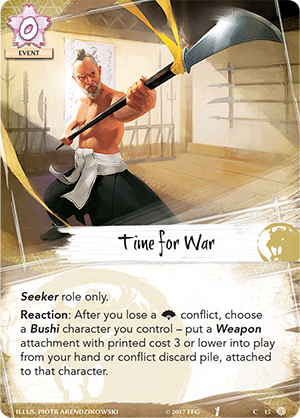 I am not, nor will I ever be, a samurai of Rokugan. Beyond the simple fact that Rokugan is a fictional world, the term “samurai” holds a great cultural significance in Japan. It denotes a historical role with that ethnicity, with a centuries-heavy legacy. While it is a title which can be earned by non-Japanese (and has been, including an African man in the 1500s), such a practice ended in the 19th century. Addressing the players as the samurai of Rokugan is a practice that is at once unnecessary and questionably offensive.
I am not, nor will I ever be, a samurai of Rokugan. Beyond the simple fact that Rokugan is a fictional world, the term “samurai” holds a great cultural significance in Japan. It denotes a historical role with that ethnicity, with a centuries-heavy legacy. While it is a title which can be earned by non-Japanese (and has been, including an African man in the 1500s), such a practice ended in the 19th century. Addressing the players as the samurai of Rokugan is a practice that is at once unnecessary and questionably offensive.
Be a fan of L5R. Be a Crane Clan loyalist. Be a person who acts with honor and looks with admiration and affection towards the samurai of legend and emulates their actions. These are all good things, but none of them require you to be addressed as a samurai. I may play a character who is a samurai of Rokugan. I, however, am not.
Thank you for your patience today, dear reader, and I hope that this has been enlightening. It is important to remember that growth comes often through conflict, both internal and external, and we can truly make this decades-old game a better one if we continue to work at it.
And with that in mind, I hope you return for my next installment, where I discuss the Organized Play environment going into the Worlds Championship in November, and how the decisions at Gen Con are changed there.
Until then, Carry the Fortunes.

David Gordon was a regular contributor to the site. A storyteller by trade and avowed tabletop veteran, he also has a long and complicated past with L5R. These were his stories. He can be reached on Twitter.
You can discuss this article and more on our social media!
Photo Credits: Legend of the 5 Rings images by Fantasy Flight Games, Deadlands cover by Pinnacle.

